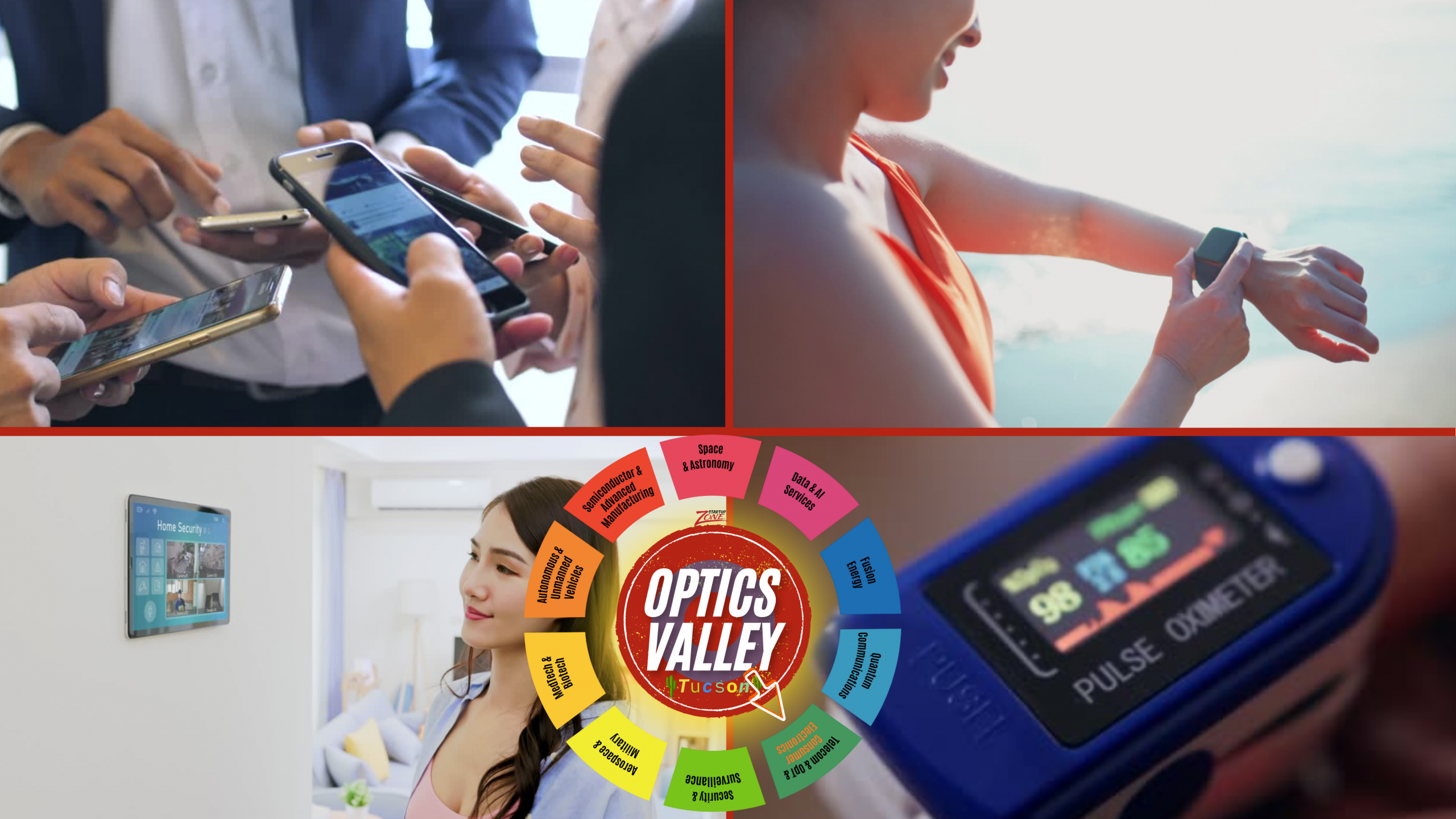Invisible Sensors of Consumer Electronics
Powered by Optics Valley
From the moment most of us wake up to the moment we go to bed, we interact with technologies powered by optics and photonics. Smartphones, wearables, televisions, gaming consoles, home automation devices, and even kitchen appliances all rely on the manipulation of light. While consumers rarely notice the advanced science behind these devices, optics and photonics form the invisible backbone that enables performance, convenience, and seamless digital experiences.
I have attempted to capture the most common consumer products that use optics and phonics for sensing, vision, and lighting applications. This article explores the critical uses of optics and photonics in consumer electronics, detailing the technologies and their delivered utility that make our modern lifestyles possible.
Smartphones: The Ultimate Photonics Platform
No consumer product embodies the convergence of optics and photonics like the smartphone. It combines imaging, sensing, and communication into a compact form factor.
Cameras and Imaging
- Lens systems: Smartphones use complex multi-element miniature lenses, typically molded plastic or hybrid glass, to achieve wide-angle and telephoto capabilities. Advanced lens coatings reduce reflections and improve color fidelity.
- Image sensors: CCDs and, more commonly today, CMOS sensors convert incoming photons into electrical signals. Modern sensors use backside illumination (BSI) to increase light capture efficiency in low-light conditions.
- Optical image stabilization (OIS): Tiny actuators physically shift lenses or sensors to counteract hand movement, using gyroscopic sensors as feedback.
- Computational photography: While technically software-driven, it depends on optics-enabled data capture from multiple lenses and sensors working together.
Biometric Sensing
- Face recognition: Structured light or time-of-flight (ToF) 3D sensing projects infrared dots across a user’s face. A dedicated IR sensor captures the reflected pattern to build a depth map for secure identification.
- Fingerprint scanning: Under-display optical fingerprint sensors illuminate the finger and capture reflected light patterns for authentication.
Display Technologies
- OLED and microLED displays: Both technologies use photonics to emit light directly from organic compounds or micro-scale LEDs. They rely on thin-film optics and precision manufacturing to deliver high resolution and brightness with low power consumption.
- Protective optics: Gorilla Glass and sapphire coatings use optical transparency with high scratch resistance, ensuring clarity while withstanding daily wear.
Wireless Communication
- Optical filters and antennas: Even in RF communication, photonics plays a role, as optical filters help reduce noise and interference in the chipsets that manage 4G/5G signals.
Smartphones are now effectively pocket-sized optical laboratories, blending light-based technologies in imaging, sensing, and display.
Wearables: Optics on the Body
Smartwatches, fitness trackers, and AR/VR headsets extend optical technology beyond handheld devices.
Health Monitoring
- Photoplethysmography (PPG): Green, red, or infrared LEDs shine into the skin, and photodiodes measure changes in reflected light caused by blood volume pulses. This is the basis for heart rate and blood oxygen sensors.
- Optical biosensing: Advanced wearables use spectroscopy principles to estimate hydration, stress levels, or glucose monitoring (non-invasive solutions are still developing but highly promising).
Augmented and Virtual Reality
- Head-mounted displays (HMDs): AR/VR devices depend on miniature displays combined with complex optics, waveguides, Fresnel lenses, and pancake optics to deliver immersive visuals.
- Eye tracking: Infrared light sources and cameras track eye movement to improve rendering efficiency and enable foveated rendering.
- Gesture recognition: Depth-sensing cameras (often ToF or structured light) allow intuitive hand-based interaction without controllers.
Wearables transform optical science into personal health tools and immersive experience platforms.
Televisions and Home Displays: Photonics at Scale
The living room remains one of the most visible showcases of photonics innovation.
Display Panels
- LCD (Liquid Crystal Display): Uses backlight systems with LEDs, optical polarizers, liquid crystals, and color filters to form images.
- OLED (Organic Light-Emitting Diode): Self-emissive pixels based on organic molecules offer deep blacks, wide color gamut, and fast refresh rates.
- MicroLED: A cutting-edge technology using millions of microscopic LEDs arranged in precise arrays for unmatched brightness and efficiency.
Projection Systems
- Laser projectors: Replacing traditional bulbs, lasers provide bright, consistent, and long-lasting light sources. Optical engines use diffraction gratings, prisms, and DLP chips to project crisp, high-resolution images.
HDR and Color Management
- Quantum dot enhancement: Displays now often use quantum dot films, nanoscale semiconductors that emit pure, tunable colors when excited by light, dramatically improving color accuracy and brightness.
Optics in display technologies redefine how consumers experience entertainment, making photonics central to home media.
Gaming and Immersive Tech: Light Meets Interactivity
The gaming industry leans heavily on optics to create immersive, interactive environments.
Graphics Displays
- High-refresh OLEDs, HDR-enabled LCDs, and microLEDs provide fast response and vivid color for gamers who demand precision visuals.
Headsets and Controllers
- VR/AR optics: Headsets rely on waveguides, holographic optics, and advanced lens designs to overlay or replace the user’s field of view with computer-generated imagery.
- Motion tracking: Infrared LEDs and cameras track head and body position with sub-millimeter accuracy.
- Haptic feedback integration: Optical sensors in controllers detect subtle hand movements or gestures for real-time interactivity.
Cloud Gaming and Streaming
- High-bandwidth communication depends on optical fibers at the infrastructure level, ensuring low-latency streaming and interactivity.
Here, photonics is the invisible foundation of experiences that feel increasingly lifelike.
Smart Homes: Light as the Nervous System
Connected homes are filled with optical technologies that manage security, comfort, and convenience.
Security and Monitoring
- Cameras: From simple webcams to doorbell systems, optics enable motion detection, low-light imaging, and facial recognition.
- Infrared illumination: IR LEDs provide “night vision” capabilities for cameras without disturbing human sleep cycles.
Environmental Control
- Smart lighting: LED-based systems offer energy efficiency and dynamic spectrum control, mimicking circadian rhythms. Advanced models integrate Li-Fi (light fidelity) to transmit data through visible light.
- Optical sensors: Used in thermostats, smoke detectors, and smart appliances to detect movement, heat, or even air quality.
Voice Assistants and User Interfaces
- Though audio-driven, these devices often include optical components: indicator LEDs, gesture recognition cameras, or depth sensors.
Photonics powers the intelligence woven into the fabric of the modern home.
Personal Computing and Work Devices
Laptops, tablets, and peripherals use optical technologies beyond displays.
Webcams and Video Conferencing
- Optical sensors, lenses, and IR-based facial recognition support high-quality virtual interaction.
Displays
- High-resolution OLEDs, LCDs, and miniLED backlighting systems deliver productivity-friendly visuals.
- Anti-reflective and anti-glare coatings improve optical comfort.
Optical Storage (Historical, but Relevant)
- CDs, DVDs, and Blu-rays, though declining, represent significant milestones in consumer photonics, using lasers for reading and writing data at high density.
Optics ensures clarity, comfort, and connectivity even in the work-from-home era.
Consumer Photography and Videography
Beyond smartphones, dedicated cameras, drones, and action cameras showcase advanced optics.
Digital Cameras
- Interchangeable lenses: Precision optics with coatings, aspherical elements, and image stabilization.
- Sensors: Large-format CMOS sensors with backside illumination for professional-grade imaging.
Drones and Action Cams
- Wide-angle optics, gimbal-based stabilization, and high-resolution sensors capture immersive perspectives.
- Multispectral cameras in consumer drones introduce photonics capabilities once reserved for industry.
Photography continues to push optical boundaries for both professionals and hobbyists.
Optical Storage and Communications in Consumer Devices
While much of optical storage has moved to cloud systems, photonics still plays a role.
Data Transfer
- Optical interconnects, such as Thunderbolt and USB-C, rely on photonics for high-speed signaling.
- Data centers that back consumer cloud services depend on fiber optics for global reach.
Emerging Applications
- Li-Fi: Promises transforming LEDs into dual-purpose lighting and wireless communication sources.
- Holographic storage: Experimental consumer applications use volumetric optical encoding to store massive amounts of data.
The unseen photonics infrastructure keeps consumer electronics connected and expanding in capacity.
Future Directions: The Next Wave of Consumer Photonics
Looking ahead, optics and photonics will continue reshaping consumer goods and services:
- Augmented reality wearables will become as common as smartphones, enabled by waveguide optics and ultra-compact projectors.
- Non-invasive medical diagnostics in wearables will rely on advanced optical spectroscopy for continuous monitoring.
- Holographic displays will replace flat screens, using light field optics for natural depth perception.
- Quantum dot and microLED displays will set new standards for brightness and efficiency.
- Optical wireless communications (Li-Fi) may complement or replace Wi-Fi, offering ultra-fast, secure data transmission.
Photonics illuminates our devices and lights the way forward for consumer technology.
Conclusion
Optics and photonics, though often hidden beneath sleek industrial design, are essential to the functionality and appeal of consumer electronics. From the cameras in our pockets to the displays on our walls, from the wearables on our wrists to the immersive experiences of VR, light-based technologies transform human interaction with the digital world.
As devices become more interconnected, intelligent, and immersive, photonics will remain the central enabler of innovation. Consumer electronics may appear to be about processors, batteries, or software, but at their core, they are also about light.








